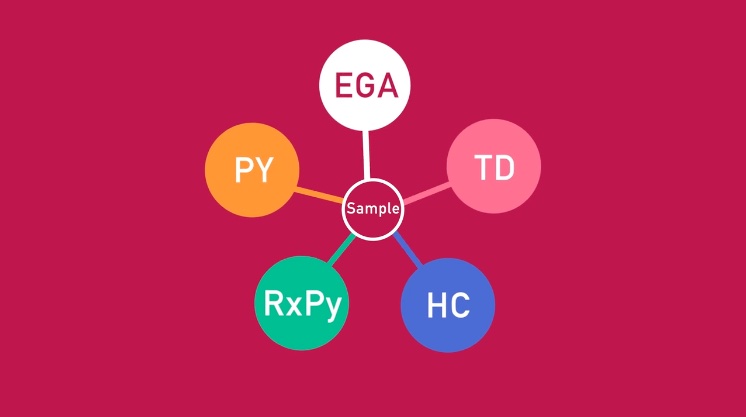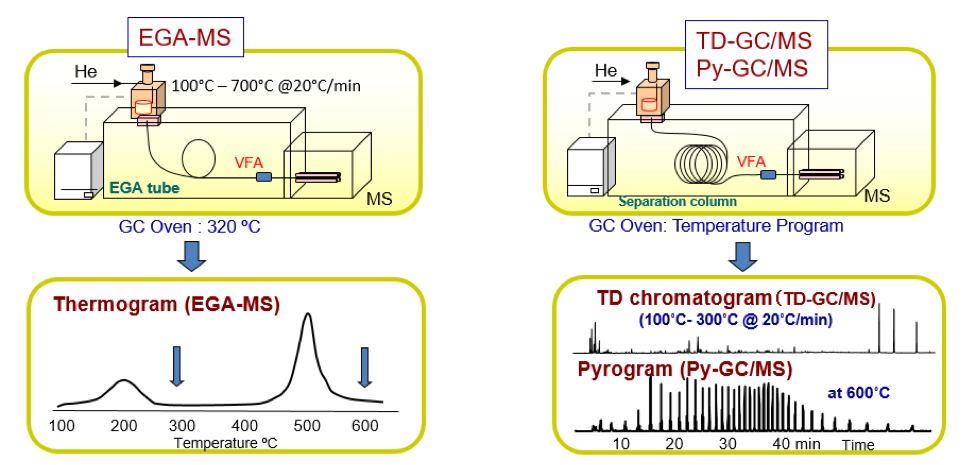
What do you do when you’re faced with an unknown sample? Enter the Method Map – your step-by-step guide to identifying unknown materials using pyrolysis.
Today, analytical pyrolysis offers much more than simple flash pyrolysis of polymers. In fact, scientists can characterize nearly any solid or liquid material using techniques built into today’s multifunctional pyrolysis systems.
Let’s break down the two-step Method Map that makes this possible.
The first step of the Method Map is Evolved Gas Analysis (EGA), which provides a clear picture of the sample’s complexity. In this technique, the sample drops into a furnace initially set at a low temperature. As the analysis progresses, the furnace heats to higher temperatures. Compounds begin to evolve from the sample, and the system generates a plot showing detector response versus temperature.
The second step of the Method Map involves analyzing the thermal zones identified in the EGA thermogram. A Frontier Selective Sampler slices out a zone and separates its components using a mass spectrometer (MS). This process, known as Heart Cutting (HC), supports up to eight programmable temperature zones for detailed analysis.
In addition to heart-cutting, the system can analyze volatile compounds using a Frontier MicroJet Cryo-trap. This tool cryo-focuses the components at the head of the analytical column before the run begins. Alternatively, you can use Thermal Desorption Gas Chromatography–Mass Spectrometry (TD-GC/MS) by programming the pyrolyzer’s micro-furnace.
After TD-GC/MS, the sample can be subjected to a pyrolysis temperature. The obtained pyrogram is then referred to as PY-GC/MS.

To bring the steps of the Method Map together, a Double-Shot method was developed using the EGA thermogram from the Frontier Multi-Shot Pyrolyzer. By programming the furnace temperature from 100 to 300 °C, you can identify volatile compounds and additives in the sample.
This stage of analysis identifies only the compounds between the set temperature range (100 – 300 °C) by transporting the evolved compounds to the head of the analytical column.
To analyze the second peak, you can set the furnace temperature to 600 °C. This allows the system to generate a pyrogram that identifies polymers and other heavier compounds.
In terms of hardware, EGA uses an uncoated stainless-steel tube to connect the GC inlet to the MS. For TD-GC/MS and PY-GC/MS, the system uses a 30-meter Frontier analytical column. Switching from the tube to the column takes just minutes with the Vent-free GC/MS Adaptor (VFA).
In summary, the Frontier Multi-Shot Pyrolyzer is an extremely efficient technique in identifying an unknown composition with two simple steps. Among its many advantages, the Frontier Multi-Shot Pyrolyzer provides a clear picture of the unknowns’ composition by identifying the thermal zones and the compounds in each zone. The instrument allows multiple analysis on a single sample, and there is no need for solvent and sample preparation.
By leveraging the power of the Method Map and the Frontier EGA/PY-3030D pyrolysis system, you can expand the boundaries of your material characterization.
References:
Complete this form below to sign up and we will reach out to you with instructions
